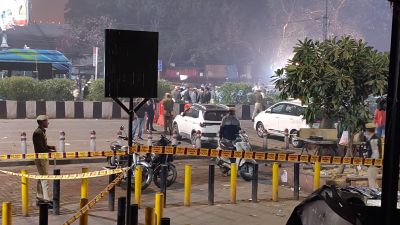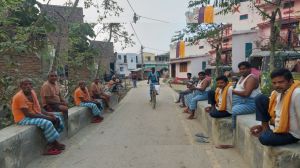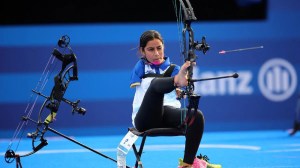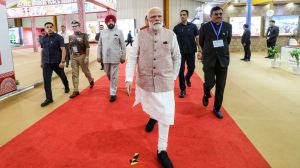Nitish shows Paswans the Mahadalit carrot
Bihar Chief Minister Nitish Kumar declared that the state govt would begin distributing three decimals of land to landless Paswans.
The setting was apt and,by itself,the announcement was hardly controversial. At a Dalit conference in Patna on April 4 to mark the birth anniversary of Baba Chauharmal,revered among the Paswans,Bihar Chief Minister Nitish Kumar declared that the state government would begin distributing three decimals of land to landless Paswans,a promise it has earlier made to the newly minted category of Mahadalits in the state.
Yet Kumars announcement has touched off an extraordinary question: If every Dalit group in Bihar has been officially designated as Mahadalit,or will be treated as such by the government,who is a Dalit in Bihar? Or conversely,if all Dalits are now Mahadalits,or to be treated as such,who is a Mahadalit?
The story so far: In 2007,the Bihar government set up the Mahadalit Commission to identify the Mahadalits,that is,the most deprived of the deprived,ostensibly for better targeting of schemes for their uplift and development. According to the Commission,there were three criteria of inclusion: literacy rates,placement in services and social stigma.
To begin with,the Mahadalit Commission identified 18 of Bihars 22 Dalit castes as Mahadalit. That is,all Dalit groups except four: Jatavs and Paswans,the two most numerically dominant groups,together accounting for more than 60 per cent of Bihars SC population,and Dhobis and Pasis,the two groups considered relatively better off in terms of development parameters among Dalits.
A year later,in 2008,Pasis and Dhobis were also included in the Mahadalit list. In 2009,the Jatavs followed them into the burgeoning Mahadalit ranks,leaving out only the Paswans. And now,Nitish has promised to Paswans that the government would extend to them the special schemes it has designed for Mahadalits. So is Nitish setting the stage for the formal induction of the Paswans into the Mahadalit category,in the process abolishing the very distinction his government was responsible for creating with much political fanfare in 2007?
That situation (of all Dalits becoming Mahadalits) will not arise. Leaders of the Paswan community have said they do not want to be included in the Mahadalit list. They consider it a term of abuse, says Babban Rawat,member of the Mahadalit Commission. There is no question of including anyone in Mahadalits now, says K P Ramaiah,secretary of the Commission.
But Ramaiah admits that the facilities that are being given to Mahadalits will also be given to Paswans. These include,apart from the three decimals of land,job training,toilet and health facilities,distribution of uniforms to school-going children from Class I to V,and formation of self-help groups.
According to sources in the Commission,all the benefits to Mahadalits will eventually be extended to Paswans in one form or another,with a little variation. For instance,the Bihar Mahadalit Vikas Mission pledges to enrol and ensure retention of students from Mahadalit families by the appointment of a Local Resource Person (Vikas Mitra) who will be in direct consultation with the Mahadalit families and will also ensure the implementation of other schemes. For the Paswans,the plan is to appoint the Vikas Mitra by another name he will be called the Suraksha Mitra.
Sensing his opportunity,Ram Vilas Paswan,the leading claimant of the states Paswan vote bank,throws down a challenge: If the Paswans also get three decimal land,like the Mahadalits,then why create the separate category? Will Nitish Kumar tell the people this: which of the benefits given to Mahadalits will be denied by his government to the Paswans?
According to Paswan,the creation of the Mahadalit category was a ploy to divide the Dalits. But as the groups left out of the Mahadalit circle mounted pressure and agitations with Paswans own Lok Janshakti Party taking the lead Nitish buckled under the pressure,and included more and more Dalit groups till only one remained outside the boundary. On April 3,Paswan points out,he had called a Dalit Sena Sammelan in Patna,in which a decision was taken to launch a statewide agitation against the Nitish government. A day later,Nitish announced the three decimal land benefit for Paswans.
Ali Anwar,a JD(U) MP and the partys chief in the Upper House,explains the inexorable expansion of the Mahadalit category in Bihar by drawing a parallel with the JD(U)s flexibility on the Womens Reservation Bill after Nitish publicly urged his party to reconsider its oppositional stand. Just as we showed flexibility on the issue of womens reservation,we are doing the same vis-a-vis demands for inclusion in the Mahadalit list. We are open to new facts and figures. Why should the poor among the Paswans be discriminated against? he says. We are not snatching away from one to give to the other,we are only reaching out to more groups.
As Dalit versus Mahadalit becomes the new political battle in Bihars election year,the states misfortune is specially amplified by this tug-of-war of the deprived. While Dalits lag behind the other castes on all socio-economic indices all across the country,Bihars Dalits uniformly lag behind those in other states.
With 93.3 per cent residing in rural areas,Dalits in Bihar are overwhelmingly rural. According to the 2001 Census,the sex ratio of Bihars Dalit population is 923 females per 1,000 males,lower than the national average of 936 for all Dalits. The overall literacy rate of Bihars Dalits is 28.5 per cent,nearly half of the 54.7 per cent recorded for all SCs. More than three-fourth of the total Dalit workers in Bihar are agricultural labour,far higher than the national average of 45.6 per cent.



- 01
- 02
- 03
- 04
- 05




























